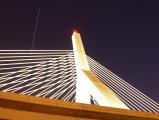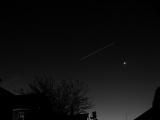

This page includes information related to the "Sky Searching" panel (satellite observation), and my photographs in the art show. Scroll down for details.
If you're seeing this as a handout at the convention, this page (with the links) is http://www.golux.org/topics/arisia2012
Summary: Spacecraft, satellites, and spent rocket stages in Earth orbit can be seen from the ground, looking like bright stars moving across the sky. On a typical evening, several satellites are bright enough to see, even from well-lit urban environments. Most people have seen orbiting satellites, but mistaken them for airplanes. Like the planets, satellites are visible by reflected sunlight. In the middle of the night, satellites fly through the Earth's shadow, and are invisible. But in the hours before dawn and after dusk, when it's still daylight at orbital altitudes, satellites can be observed floating across the night sky. Satellites are best observed with the unaided eye - a telescope is not needed (or even helpful for the casual observer, because they move so quickly across the sky).
Satellites follow predictable orbital tracks, and predictions are available from heavens-above.com. If you're near Boston, you can use these direct links (the website calculates upcoming satellite passes on request, so the links can be used or bookmarked at any time, they're not specific to the convention):
For any satellite pass, it's helpful to go outside about 5-10 minutes before the predicted time, so your eyes have a chance to adapt to darkness, and you have time to get oriented and find the right part of the sky.
Information for some specific satellite passes during 2012 Arisia:
The new Chinese space station (still unmanned) will be visible for several minutes on Sunday evening, at about 5:11 pm, look high in the southern sky (50 degrees elevation), and it will be moving from west to east. The satellite is expected to pass just below the planet Jupiter, the brightest object high in the south, and will be somewhat fainter than Jupiter. Examples of what a satellite looks like (time exposures, the satellite is a moving point of light, and comes across in the photographs as a line):
The Iridum 90 spacecraft will flare for a few seconds on Sunday evening, 6:20:57 pm (yes, that's accurate to the second!) and is expected to be approximately 40 times brighter than the planet Venus. Look 45 degrees high in the northeast sky. Examples below:
The International Space Station is the brightest satellite in orbit, but during 2012 Arisia, ISS will be flying over in the morning sky - not too convenient for easy observation. If you happen to be awake, on Monday morning at 6:33 am, ISS will pass very high in the northwestern sky (almost straight overhead, through the Big Dipper), moving from the southwest to the northeast. ISS will be the brightest star in the sky.
Here's a photo narrative
of my trip to Cape Canaveral for STS-135, the final space shuttle launch
[http://www.golux.org/events/2011/110708-shuttle/]
For more of my photography, you can visit my Photo of the Day website
[http://photo.bluebrook.com]